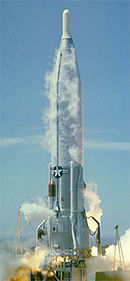
Proton is an expendable launch system used for both commercial and Russian government space launches. The first Proton rocket was launched in 1965. Modern versions of the launch system are still in use as of 2023, making it one of the most successful heavy boosters in the history of spaceflight. The components of all Protons are manufactured in the Khrunichev State Research and Production Space Center factory in Moscow and Chemical Automatics Design Bureau in Voronezh, then transported to the Baikonur Cosmodrome, where they are assembled at Site 91 to form the launch vehicle. Following payload integration, the rocket is then brought to the launch pad horizontally by rail, and raised into vertical position for launch.

Private spaceflight refers to spaceflight activities undertaken by non-governmental entities, such as corporations, individuals, or non-profit organizations. This contrasts with public spaceflight, which is traditionally conducted by government agencies like NASA, ESA, or JAXA.

The Angara rocket family is a family of launch vehicles being developed by the Moscow-based Khrunichev State Research and Production Space Center. The launch vehicles are to put between 3,800 kg (8,400 lb) and 24,500 kg (54,000 lb) into low Earth orbit and are intended, along with Soyuz-2 variants, to replace several existing launch vehicles.
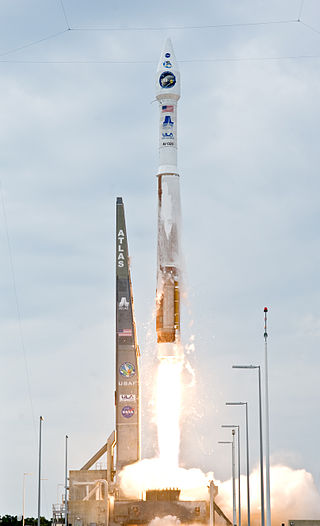
Atlas V is an expendable launch system and the fifth major version in the Atlas launch vehicle family. It was originally designed by Lockheed Martin, now being operated by United Launch Alliance (ULA), a joint venture between Lockheed Martin and Boeing. It is used for DoD, NASA, and Commercial payloads. It is America's longest-serving active rocket. After 87 launches, in August 2021 ULA announced that Atlas V would be retired, and all 29 remaining launches had been sold. As of January 2024, 17 launches remain. Other future ULA launches will use the new Vulcan Centaur rocket.

Space Launch Complex 3 (SLC-3) is a launch site at Vandenberg Space Force Base that consists of two separate launch pads. SLC-3E (East) was used by the Atlas V launch vehicle before it was decommissioned in August 2021 with the final launch taking place on November 10, 2022 at 09:49, while SLC-3W (West) has been demolished.

The Nimiq satellites are a Canadian fleet of geostationary telecommunications satellites owned by Telesat and used by satellite television providers including Bell Satellite TV and EchoStar. 'Nimiq' is an Inuit word used for an object or a force which binds things together. A contest in 1998 was held to choose the name of these satellites. The contest drew over 36,000 entries. Sheila Rogers, a physiotherapist from Nepean, Ontario, submitted the winning name.

United Launch Alliance, LLC, commonly referred to as ULA, is an American aerospace manufacturer, defense contractor and launch service provider that manufactures and operates rockets that launch spacecraft into Earth orbit and on trajectories to other bodies in the Solar System. ULA also designed and builds the Interim Cryogenic Propulsion Stage for the Space Launch System (SLS).

A modular rocket is a kind of multistage rocket which has components that can interchanged for different missions. Several such rockets use similar concepts such as unified modules to minimize expenses on manufacturing, transportation and for optimization of support infrastructure for flight preparations.

The Khrunichev State Research and Production Space Center is a Moscow-based manufacturer of spacecraft and space-launch systems, including the Proton and Rokot rockets, and the Russian modules of Mir and the International Space Station.
The Briz-K, Briz-KM and Briz-M are Russian liquid-propellant rocket orbit insertion upper stages manufactured by Khrunichev State Research and Production Space Center and used on the Proton-M and Angara A5. The upper stages were also used on Rokot, one of Russia's smaller launchers, before its retirement in 2019.
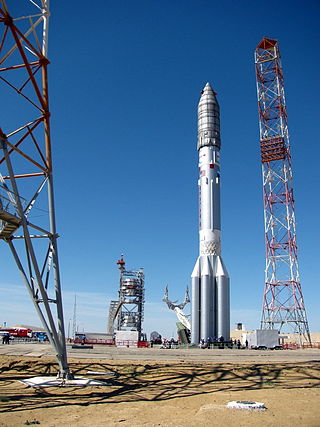
The Proton-M, (Протон-М) GRAU index 8K82M or 8K82KM, is an expendable Russian heavy-lift launch vehicle derived from the Soviet-developed Proton. It is built by Khrunichev, and launched from sites 81 and 200 at the Baikonur Cosmodrome in Kazakhstan. Commercial launches are marketed by International Launch Services (ILS), and generally use Site 200/39. The first Proton-M launch occurred on 7 April 2001.

Commercial Resupply Services (CRS) are a series of flights awarded by NASA for the delivery of cargo and supplies to the International Space Station (ISS) on commercially operated spacecraft. The first CRS contracts were signed in 2008 and awarded $1.6 billion to SpaceX for twelve cargo Dragon and $1.9 billion to Orbital Sciences for eight Cygnus flights, covering deliveries to 2016. The Falcon 9 and Antares rockets were also developed under the CRS program to deliver cargo spacecraft to the ISS.
Glavkosmos is a subsidiary of the Russian State Space Corporation Roscosmos.
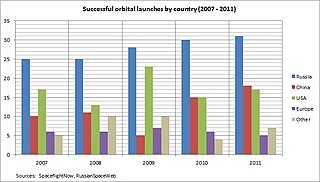
Russia's space industry comprises more than 100 companies and employs 250,000 people. Most of the companies are descendants of Soviet design bureaux and state production companies. The industry entered a deep crisis following the dissolution of the Soviet Union, with its fullest effect occurring in the last years of the 1990s. Funding of the space program declined by 80% and the industry lost a large part of its work force before recovery began in the early 2000s. Many companies survived by creating joint-ventures with foreign firms and marketing their products abroad.
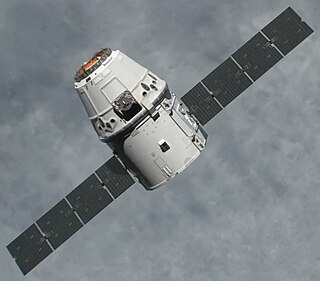
The year 2012 saw a number of significant events in spaceflight. In May and October, the first Commercial Orbital Transportation Services resupply missions took place, during which the SpaceX Dragon became the first private spacecraft to dock with the International Space Station (ISS). In June, China launched the crewed Shenzhou 9 orbital mission, and North Korea achieved its first successful orbital launch in December. 2012 also saw China's first successful asteroid exploration mission, and the landing of NASA's Curiosity rover on Mars. The Vega and Unha-3 rockets made their maiden flights in 2012, while the Proton-K made its last.
AMC-9 is a commercial broadcast communications satellite owned by SES World Skies, part of SES S.A. Launched on 6 June 2003, from Baikonur Cosmodrome, Kazakhstan, on the 300th launch of a Proton family rocket, AMC-9 is a hybrid C-band / Ku-band satellite located at 83° West, covering Canada, United States, Mexico, and Caribbean. It is owned and operated by SES S.A., formerly SES Americom.

Irtysh, also named Soyuz-5, formerly codenamed Fenix in Russian and Sunkar in Kazakh, is a planned Russian rocket that is being developed by JSC SRC Progress within the "Project Feniks". Initially it will replace the capability of Zenit-2 and Proton Medium, and in the future will serve as the base of a super heavy-lift launch vehicle rocket (Yenisei) to match the Energia/Buran capabilities. As of August 2023, Irtysh is expected to launch from the Baikonur Baiterek, the ex Zenit-2 launch site, in a partnership with the government of Kazakhstan, with a planned debut in December 2025.















